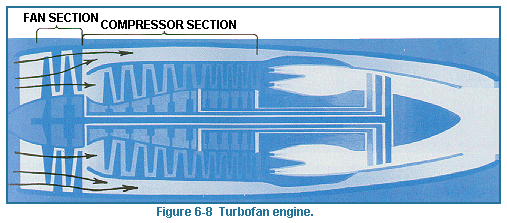 |
|||||
| Home | Research | For Teachers | HISTORY Level 1 Level 2 Level 3 |
PRINCIPLES Level 1 Level 2 Level 3 |
CAREER Level 1 Level 2 Level 3 |
| Gallery | Hot Links | What's New! | |||
| Web Administration and Tools | |||||
 |
|||||
| Home | Research | For Teachers | HISTORY Level 1 Level 2 Level 3 |
PRINCIPLES Level 1 Level 2 Level 3 |
CAREER Level 1 Level 2 Level 3 |
| Gallery | Hot Links | What's New! | |||
| Web Administration and Tools | |||||
![]()
The turbofan engine has gained popularity for a variety of reasons. As shown in Figure 6-8, one or more rows of compressor blades extend beyond the normal compressor blades. The result is that four times as much air is pulled into the turbofan engine as in the simple turbojet. However, most of this excess air is ducted through bypasses around the power section and out the rear with the exhaust gases. Also, a fan burner permits the burning of additional fuel in the fan airstream. With the burner off, this engine can operate economically and efficiently at low altitudes and low speeds. With the burner on, the thrust is doubled by the burning fuel, and it can operate on high speeds and high altitudes fairly efficiently. The turbofan has greater thrust for takeoff, climbing, and cruising n the same amount of fuel than the conventional turbojet engine.

With better all-around performance at a lower ate of fuel consumption, plus less noise resulting from its operation, it is easy to understand why most new jet-powered airplanes are fitted with turbofan engines. This includes military and civilian types.
The force produced by a jet engine is expressed in terms of pounds of thrust. This is a measure of the mass or weight of air moved by an engine times the acceleration of the air as it goes through the engine. Technically, if the aircraft were to stand still and the pressure at the exit plane of the jet engine was the same as the atmospheric pressure, the formula for the jet engine thrust would be:
weight of air in pounds per second X velocity
Thrust = --------------------------------------------------------------
32.2 (normal acceleration due to gravity, in feet per second2)
Imagine an aircraft standing still, capable of handling 215 pounds of air per second. Assume the velocity of the exhaust gases to be 1,500 feet per second. The thrust would then be:
215 lbs of air per second
Thrust = --------------------------- X 1,500 feet per second= 6.68 X 1,500 =
32.2 feet per second2
Thrust = 10,020 lbs
If the pressure at the exit plane is not the same as the atmospheric pressure and the aircraft were not standing still, the formula would be someone different (See Level 3).
It is not very practical to try to compare jet engine output in terms of horsepower. As a rule of thumb, however, you might remember that at 375 miles per hour (mph), one pound of thrust equals one horsepower; at 750 mph, one pound of thrust equals two horsepower.
Send all comments to ![]() aeromaster@eng.fiu.edu
aeromaster@eng.fiu.edu
© 1995-98 ALLSTAR Network. All rights reserved worldwide.
| Funded in part by | From Civil Air Patrol Educational Materials |
Updated: February 23, 1999